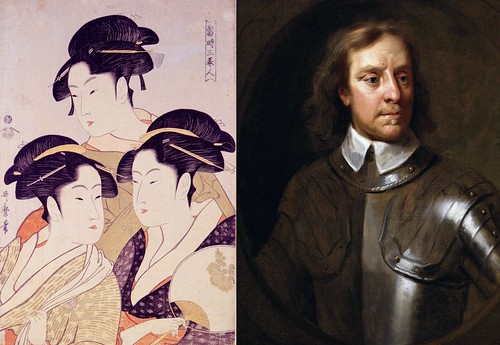Tuesday, September 05, 2017
Japanese and Western Art

When Western pictorial art arrived in Japan in the late Edo period the Japanese were amazed at how photographic it was. One of the first famous Western-Style Japanese artists, Shiba Koukan, wrote
"What is remarkable is that it (Western Art) enables one to see clearly something that is actually not there. If a painting does not truly portray a thing it is devoid of the wonderful power of art. Fuji-san is a mountain unique in the world, and foreigners who wish to look at it can do so only in pictures. However, if one follows only the orthodox Chinese methods of painting, one’s picture will not resemble Fuji, and there will be node of the magical quality in it that painting possesses. The way to depict Fuji accurately is by means of Dutch painting." (Shiba Koukan see Keene, 1952 p.67)
The traditional Japanese painting, following its Chinese model, attempted to "delineate the spirit" (Keene, 1952, p.66) of the subject resulting in idealised or mangarized representations of "beautiful women" (bijinga) for instance. The women in Japanese biinga (above left) are as uniform as those in Anime, and the mountains in Japanese and Chinese art, sharing essence of beauty or mountain.
To Westerners however, the image is usually seen as superficial, "mere image," (Aristotle, see Brenkman, 1976) a fact which facilitates the pictorial representation of people "warts and all" such as in the famous picture of Oliver Cromwell, above right.
This is the reverse of the situation in verbal, linguistic representations of people wherein Westerners are generally very idealised (braggart) and uniform, whereas Japanese say it how it is (Heine, Lehman, Markus, & Kitayama, 1999; T. R. S. Leuers = Takemoto & Sonoda, 1999; T. Leuers = Takemoto & Sonoda, 1999; T. Takemoto & Iwaizono, 2016; T. R. Takemoto & Brinthaupt, 2017; see also Takemoto, T. 武本, Timothy, 2017).
More notes
From Jay 1993, p13
Monotheistic religions, beginning with Judaism, have been deeply wary of pagan idolatry. The fictional character of artificial images, which can only be false simulators of the "truth," has occasioned distrust among more puritanical critics of representation. St. Pauls celebrate warning against the speculum obscurum, the glass (or mirror) through which we only see but darkly, vividly express this caution about terrestrial sign. Religious distrust was also aroused by teh capacity of vision to inspire what Augustine condemned as conupiscentia ocularum, ocular desire, which diverts our minds from more spiritual concerns. These and like suspicious have at times come to dominate religious movements and dictate long-standing religious taboos. Mose's strugge with Aaron over the Golden Calk, the Islamic rejection of figural representation, the iconoclastic controversy of the ieghth-centruy Byzantine church, the Cistercian monasticism of St. Bernard, the English Lollards, and finale the Protestant Reformation all express the antiocular sub-current of [Western] religious thought. In fact this hostility remains alive today. in the worl of such theologians as Jaqcues Ellul, whos Humiliation of the Word, written in I981, reads like a summa of every imaginable religious complaint against the domination of sight.
Images
Late 17th century Left Beauties by Utamaro Kitagawa
Oilver Cromwell, "Warts and All" by Sir Peter Lely
Bibliography
Brenkman, J. (1976). Narcissus in the Text. Georgia Review, 30(2), 293–327. Retrieved from www.jstor.org/stable/41399656
Heine, S., Lehman, D., Markus, H., & Kitayama, S. (1999). Is There a Universal Need for Positive Self-Regard? Psychological Review, 106(4), 766–794. Retrieved from humancond.org/_media/papers/heine99_universal_positive_re...
Jay, M. (1993). Downcast eyes: The denigration of vision in twentieth-century French thought. Univ of California Press. dq=Downcast+Eyes:+The+Denigration+of+Vision+in+Twentieth-Century+French+Thought&ots=SFqXjWmi3P&sig=HgLHWdIcJGXKiAVAmqMCyioZJD0
Keene, D. (1952). The Japanese Discovery of Europe: Honda Toshiaki and Other Discoverers, 1720-1798. Routledge and Kegan Paul.
Leuers = Takemoto, T. R. S., & Sonoda, N. (1999). Independent self bias. Progress in Asian Social Psychology, 3, 87–104. Retrieved from www.nihonbunka.com/docs/independent_self.rtf
Leuers = Takemoto, T., & Sonoda, N. (1999). The eye of the other and the independent self of the Japanese. In Symposium presentation at the 3rd Conference of the Asian Association of Social Psychology, Taipei, Taiwan. Retrieved from nihonbunka.com/docs/aasp99.htm
Takemoto, T., & Iwaizono, M. (2016). Autoscopic Individualism: A Comparison of American and Japanese Women’s Fashion Magazines. 山口経済学雑誌= Yamaguchi Journal of Economics, Business Administrations & Laws, 65(3), 173–205. Retrieved from ci.nii.ac.jp/naid/40021076383/
Takemoto, T. R., & Brinthaupt, T. M. (2017). We Imagine Therefore We Think: The Modality of Self and Thought in Japan and America. 山口経済学雑誌 (Yamaguchi Journal of Economics, Business Administrations & Laws), 65(7・8), 1–29. Retrieved from nihonbunka.com/docs/Takemoto_Brinthaupt.pdf
Takemoto, T. 武本, Timothy. (2017). ジマンガ:日本人の心像的自尊心を測る試み(Auto-Manga as Prideful-Pictures: An Attempt to Measure Japanese Mental Image Self-Esteem). 山口経済学雑誌= Yamaguchi Journal of Economics, Business Administrations & Laws, 65(6), 107–138. Retrieved from nihonbunka.com/docs/Jimanga.pdf
Labels: japanese culture, Nacalian, nihonbunka, 日本文化
This blog represents the opinions of the author, Timothy Takemoto, and not the opinions of his employer.
